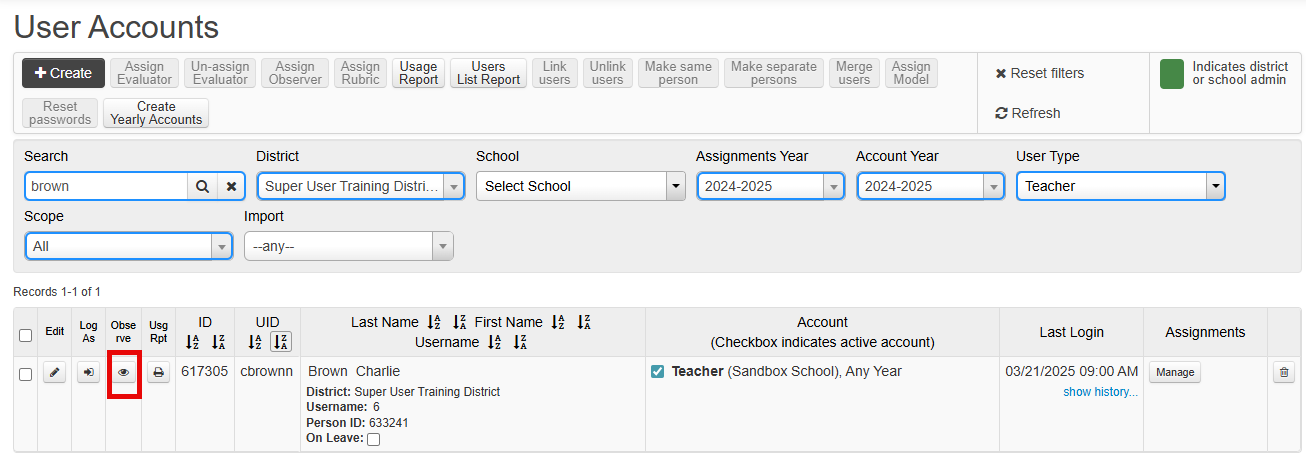Accountability: Creating a Teacher Observation/Evaluation
Click here to view the Help Video
Introduction:
eDoctrina's OBSeRVE module allows specific users within the district (usually School and District Admins) to observe, rate, and communicate with staff members at their associated school or district. There are various configurations and processes that districts may use for their yearly staff observations, but the OBSeRVE Dashboard is designed to make these processes easier by providing the tools to ensure that minimum observations are completed for each staff member that they are prescribed to.
Starting an Observation with Assignments
If the appropriate rubric assignments have been made at the beginning of the year, it is a best practice to begin all observations from the Assignments layout of OBSeRVE Dashboard. Navigate to OBSeRVE Dashboard by finding the the link under the "Quick Links" menu in the navigation bar.

After successfully arriving at the OBSeRVE Dashboard, it is important to ensure that the Assignments layout view is selected because this is where observations will be managed if assignments have been made. While all filters have a utility that cannot be understated, it is ultimately very important to select the appropriate rubric in the filters because assignments will ONLY display for each selected rubric.

If the assignments have been made and the filters have been selected properly, the required observations for each respective observee should display in the list in a manner that looks very similar to the image below. Each logged in user will only be able to find teachers of staff members that they have access to which is determined by role or specific assignment. If it is necessary to observe or evaluate a staff member that is not accessible, please reach out to a district admin or the eDoctrina team for assistance.

To begin a required observation, simply click on the appropriate  to enter into the OBSeRVE Editor.
to enter into the OBSeRVE Editor.
Starting an Observation without Assignments
If eDoctrina's assignment feature is NOT being used, a new observation can always be started by searching for the staff member by name and the clicking on the observee's name

If this approach is taken, it is up to the observer to select the appropriate rubric or observation type from the pop-up menu that results. Click on "Create" then choose the appropriate rubric and add the form.

Maximum Constraints
A rubric and/or observation type can be configured to have a maximum limitation. This is usually done for better management of the database as well as to ensure overall calculations are correct.
If the creation of a new observation will result in a violation of this maximum constraint, then the logged in user will be presented with the following message listing the other observations/evaluations that already exist in the selected rubric or observation type. Sometimes this alert will simply remind the observer that they have already started this observation in which they can simply click the observation ID# to navigate to that observation instead.

Staff Folders for Observations
If assignments are not being used, observers can begin an observation by selecting the  in other screens as well. The most popular screen to begin an observation outside of the OBSeRVE Dashboard is the User Acconts screen. Find the observee in the list here by utilizing the filters, then click the
in other screens as well. The most popular screen to begin an observation outside of the OBSeRVE Dashboard is the User Acconts screen. Find the observee in the list here by utilizing the filters, then click the  next to the observee to begin an observation.
next to the observee to begin an observation.

After clicking the  , eDoctrina will navigate the observer to the "Observation Form" page for the respective observee. This page allows for observers to add a new, edit existing, and/or view observations for this teacher. In any scenario, it is required to select the appropriate filters before any task is performed here. It is also a best practice to view the existing observations for each observee before adding a new observation to ensure that there is not an existing observation for this observee completed, scheduled, or drafted.
, eDoctrina will navigate the observer to the "Observation Form" page for the respective observee. This page allows for observers to add a new, edit existing, and/or view observations for this teacher. In any scenario, it is required to select the appropriate filters before any task is performed here. It is also a best practice to view the existing observations for each observee before adding a new observation to ensure that there is not an existing observation for this observee completed, scheduled, or drafted.

 Save as PDF
Save as PDF